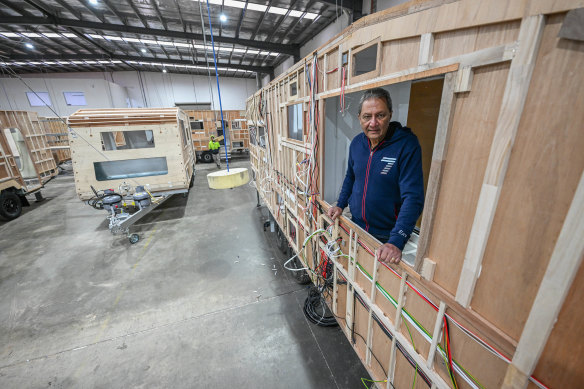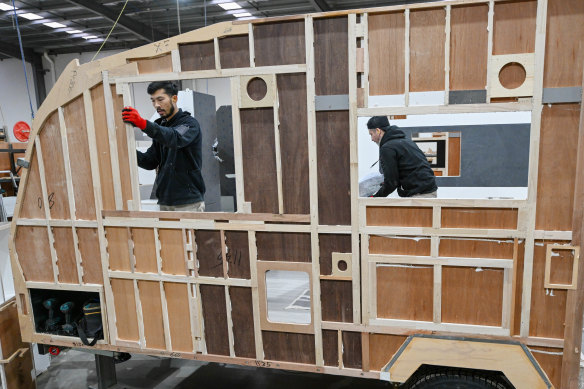By Adam Carey
Inside a plain grey factory in an industrial estate in Campbellfield, teams of men and women are making caravans. Carpenters, electricians, sheet metal workers and unskilled labourers build each van by hand, in a methodical manufacturing process that takes a day and a half per van.
Almost a decade after the local car industry died, caravan-making is booming, with a workforce that numbers in the tens of thousands building vans from the ground up. Caravan-making now employs more people than Australia’s carmakers did at their peak.

Concept Caravans national manager Conrad D’Cunha says the sector has had enormous growth.Credit: Joe Armao
“We didn’t build chassis, but now we do. All fabrication is done here; we buy the aluminium, build our own furniture. The only thing we buy is appliances,” says Conrad D’Cunha, national dealer manager of Concept Caravans.
Concept Caravans’ Barry Road factory is minutes from Ford’s former Broadmeadows assembly plant, which is a vast moonscape now but employed more than 2000 people before it closed in 2016.
Large as it was, Ford’s former workforce in Melbourne’s outer north has been eclipsed by the number of people who work in caravan factories in Campbellfield and neighbouring Epping today.
An extraordinary cluster of more than 100 caravan manufacturing businesses are active in those two suburbs, and as many as 7000 people are employed there. A further 3500 work in Melbourne’s outer south-east, Caravan Industry Victoria chief executive Daniel Sahlberg says.

Workers assemble a caravan by hand inside one of about 100 caravan manufacturing businesses in Melbourne’s northern suburbs.Credit: Joe Armao
“The caravan industry actually has more than the car industry did when it was at its peak in terms of production employees. It’s one of the last true manufacturing sectors that exists [in Australia].”
Victoria’s caravan manufacturing industry was building steadily before it was supercharged by the pandemic and the closure of international borders. It has been almost uniquely resilient within a sector that has been in long-term decline since the recession of the early 1990s.
One in five Victorian jobs were in manufacturing in 1988, but by 2021 the proportion had “bottomed out” at just 8 per cent, according to figures compiled by the Victorian parliament.
The most recent data from the Australian Bureau of Statistics reveals caravan manufacturing has had a growth spurt, rising from 14,571 jobs in June 2021 to 21,171 jobs in June 2023. The 45.2 per cent increase is the largest, proportionally, of any manufacturing sector in the state.
Sahlberg joined the industry in 2000, when it was emerging from lean times that forced many manufacturers out of business. Perhaps 30 to 40 manufacturers were operating then.
“The local caravan manufacturing industry … almost collapsed in the 1990s. There were only about 4000 caravans produced [per year].”
Last year, the figure exceeded 29,000.
D’Cunha says caravan sales grew “to an extremely radical level” during the COVID years, as landlocked Australians embraced domestic holidays. Concept had two factories a decade ago and built 370 vans a year. Today it has nine and builds 1500.
‘The caravan industry actually has more than the car industry did when it was at its peak in terms of production employees.’
Daniel Sahlberg, Caravan Industry Victoria
But the boom times also led to a surge in new entrants in the manufacturing sector, some of whom are already beginning to falter due to economic headwinds, Sahlberg says. In the past year, the sector has begun to shed jobs again.
“There is a big downturn, but that’s across everywhere,” he says.
Imports are also winning a bigger slice of the market. According to industry data, Chinese-made caravans have grown from 8 per cent to 44 per cent of sales since Australia and China signed a free trade agreement in 2015.
Campbellfield is within the City of Hume, one of Melbourne’s least-advantaged local government areas. Manufacturing remains the heartbeat of the local economy, with 20 per cent of economic output and 23,000 jobs coming from the sector. About 3500 Hume residents work in caravan manufacturing.
“Where Broadmeadows was once the car manufacturing heartland of Australia, that industrial legacy has evolved with Hume now home to 90 per cent of the nation’s caravan industry,” City of Hume Mayor Naim Kurt says.
“It’s been a remarkable transformation which has been strongly supported by our council and Caravan Industry Victoria in co-ordination with our Multiversity [university, industry and council] partners to ensure that it is Hume locals who are gaining the skills and employment from this booming market.”
Bernard Rolfe, a professor of manufacturing at Deakin University, said Victoria’s caravan industry had forged on while most other parts of the automotive manufacturing sector declined because it is locally owned.
“It’s not dominated by OEMs [original equipment manufacturers] from the US or Europe,” Rolfe says.
“Ford, Toyota and General Motors [Holden] were the big OEMs in Australia, and when they decided they were going to leave, they left, and they had no need to be [manufacturing] in Australia. Whereas if you are just a mid-sized manufacturer, there’s a lot more ties to the region.”
The sector has even benefited from the car-making giants’ exit, recruiting talented staff who brought fresh thinking, Rolfe says.
The Morning Edition newsletter is our guide to the day’s most important and interesting stories, analysis and insights. Sign up here.